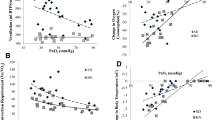Abstract
Circulating blood volume (BV) as the sum of circulating red cell volume (RCV) and plasma volume (PV) was estimated in rats native to a simulated altitude of 3500 m (“natives”), in rats born at sea level and later in life transferred to the simulated high altitude (“newcomers”), and in control sea-level rats. RCV per kg body weight (b.w.) was significantly larger in both “newcomers” and “natives” than in controls. PV per kg b.w. was in the “newcomers” insignificantly and in the “natives” significantly smaller than in the controls. BV per kg b.w. in both high altitude groups tended to be larger than in controls but the difference was not significant. Arterial haematocrit (Ahct) in the “newcomers” was significantly higher than in the controls, and in the “natives” significantly higher than in both other groups. Body haematocrit (the ratio of RCV and BV in per cent) was smaller than Ahct in all groups; this was more pronounced in the “newcomers” than in the controls and even more so in the “natives”. Apparently the haematocrit in the minute vessels of the organs of animals exposed to chronic hypoxic hypoxia increases much less than might be expected from changes of the Ahct.
An attempt was made to evaluate the possible error of the more commonly used method of estimating BV, when only RCV, or only PV, is measured, and BV and its complementary fraction are calculated from arterial or venous haematocrit. When, in our results, BV was calculated from RCV and Ahct, the absolute values and also the differences between groups were somewhat underestimated. When BV was calculated from PV and Ahct, the BV itself, and particularly the differences between groups, were overestimated quite considerably. It is suggested that the only safe way to estimate BV is to measure RCV and PV separately.
Similar content being viewed by others
References
Anthony, A., Kreider, J.: Blood volume changes in rodents exposed to simulated high altitude. Am. J. Physiol.200, 523–526 (1961)
Feigen, G. A., Johnson, P. K.: Blood volumes and heart weights in two strains of rats during adaptation to a natural altitude of 12,470 ft. In: The Physiological effects of high altitude (W. H. Weihe, ed.), pp. 45–57. Oxford: Pergamon Press 1964
Fryers, G. R.: Effect of decreased atmospheric pressure on blood volume of rats. Am. J. Physiol.171, 459–464 (1952)
Johnson, C. L., LaRoche, G.: Simulated altitude and iodine metabolism in rats: II. Effects of chronic exposure on serum and thyroid iodinated components; effects on blood fractions and some organ weights. Aerospace Med.39, 365–375 (1968)
Kasalický, J., Ressl, J., Urbanová, D., Widimský, J., Ošťádal, B., Pelouch, V., Vizek, M., Procházka, J.: Relative organ blood flow in rats exposed to intermittent high altitude hypoxia. Pflügers Arch.368, 111–115 (1977)
Pepelko, W. E.: Effect of hypoxia and hypercapnia alone and in combination upon the circulating red cell volume of rats. Proc. Soc. Exp. Biol. Med.136, 967–971 (1971)
Rakušan, K., Rajhathy, J.: Distribution of cardiac output and organ blood content in anemic and polycythemic rats. Can. J. Physiol. Pharmacol.50, 703–710 (1972)
Snedecor, G. W., Cochran, W. G.: Statistical Methods. Ames, Iowa: Iowa State University Press 1967
Tribukait, B.: Der Einfluß chronischer Hypoxie entsprechend 1000–8000 m Höhe auf die Erythropoiese der Ratte. Acta Physiol. Scand.57, 1–25 (1963)
Turek, Z., Grandtner, M., Ringnalda, B. E. M., Kreuzer, F.: Hypoxic pulmonary steady-state diffusing capacity for CO and cardiac output in rats born at a simulated altitude of 3500 m. Pflügers Arch.340, 11–18 (1973)
Turek, Z., Turek-Maischeider, M., Claessens, R., Ringnalda, B. E. M., Kreuzer, F.: Coronary blood flow in rats native to simulated high altitude and in rats exposed to it later in life. Pflügers Arch.355, 49–62 (1975)
Wolfe, R. R., Horvath, S. M.: Blood volume responses of rats adapted to different barometric pressures. Proc. Soc. Exp. Biol. Med.148, 89–93 (1975)
Author information
Authors and Affiliations
Rights and permissions
About this article
Cite this article
Turek, Z., Claessens, R., Ringnalda, B.E.M. et al. Blood volume and body haematocrit of rats native to a simulated altitude of 3500 m. Pflugers Arch. 374, 285–288 (1978). https://doi.org/10.1007/BF00585606
Received:
Issue Date:
DOI: https://doi.org/10.1007/BF00585606




